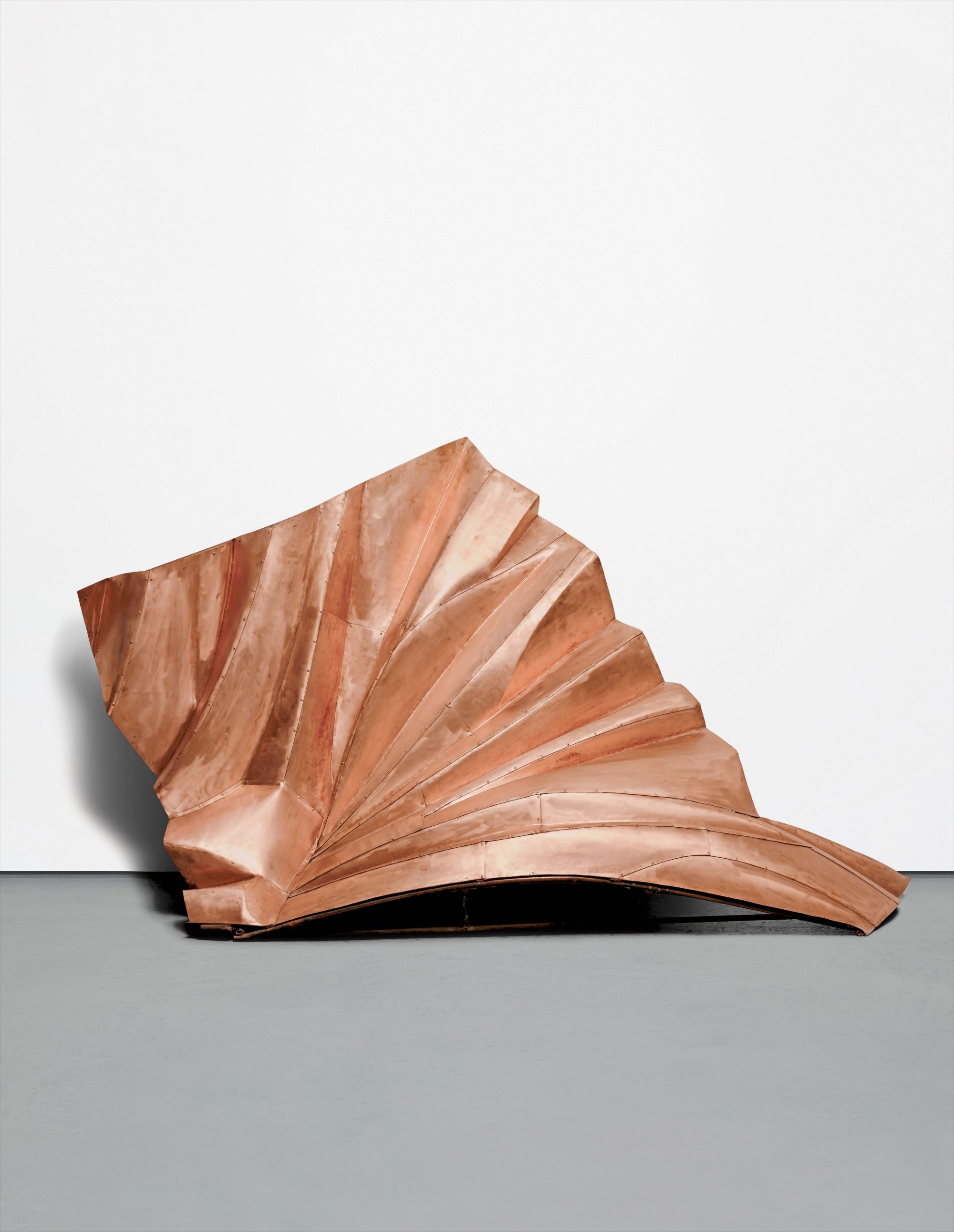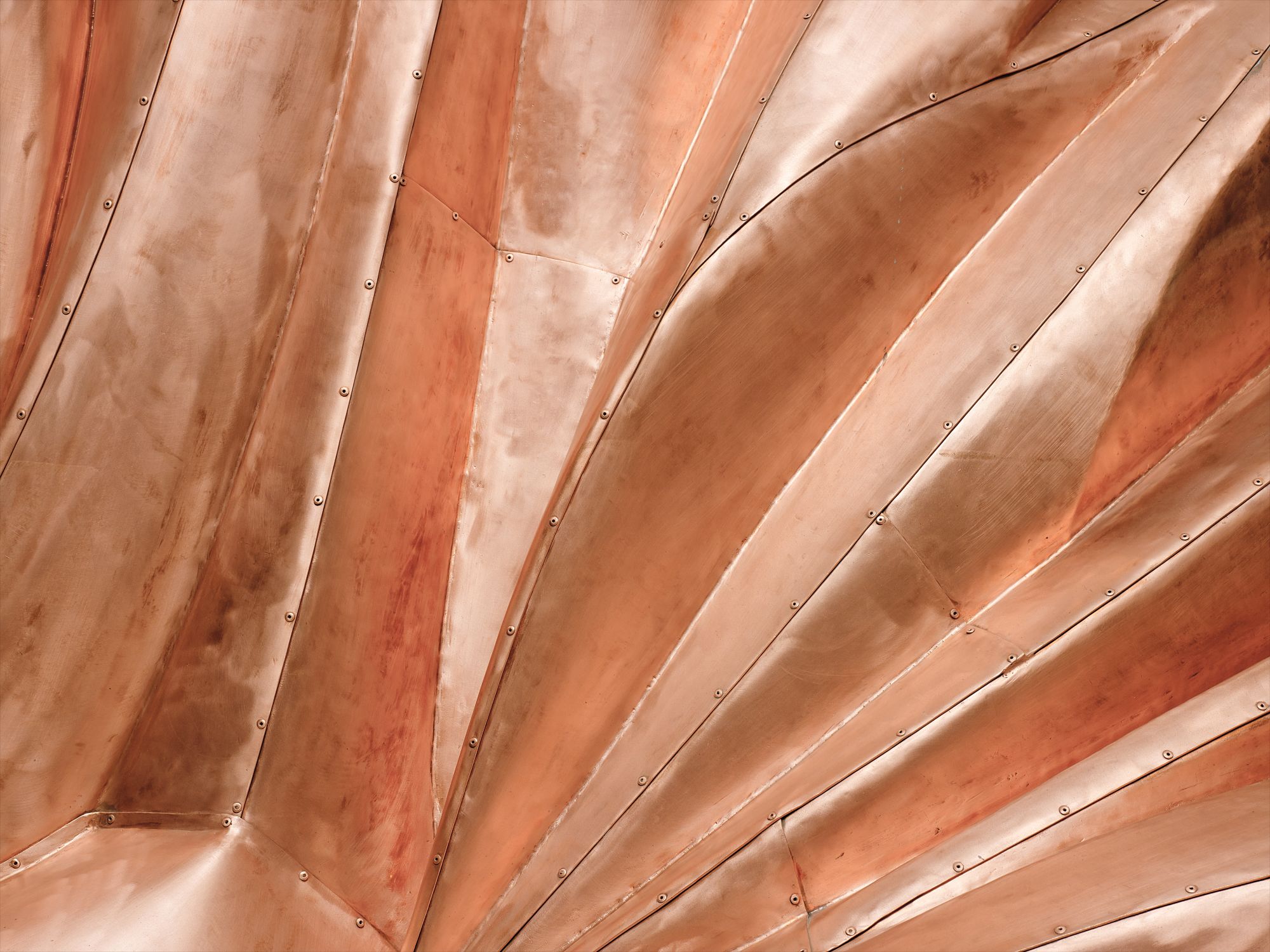



2
Danh Vo
We the People (detail)
copper
61 3/4 x 112 1/2 x 61 3/4 in. (156.8 x 285.8 x 156.8 cm)
This work is registered as element L19.1.
Full-Cataloguing
"When Bartholdi created the Statue of Liberty he created an image and a political agenda. What I'm doing with it is a shift of scale and shift of meaning." Danh Vō, 2011
Danh Vō is an artist whose practice pushes the boundaries of appropriation to its limits. Through the arrangement, rearrangement and re-contextualization of found historical artifacts, Vo explores themes of conflict driven migration and displacement and the relationships between constructed and inherited cultural values. Relying heavily on chance, Vō’s sourced material, documents or photographs are always heavily tied to history with the intention to destabilize traditional ways of thinking about these items and themes. The exploration of identity is a constant theme in Vō’s works, forming a link between his individual projects and the backbone of his incredibly cohesive practice. Utilizing his own experiences of displacement, immigration and social values, Vō investigates the formation of identity through his own. His experience of cultural displacement occurred first hand when at four years old his family fled Vietnam and settled in Denmark in the late 1970s, leaving Vō to navigate both the inherited cultural values of his background and the constructed cultural values of his adopted home that shaped his identity.
Vō’s exploration of this entanglement of personal experience and collective history intentionally undermines institutional conventions. In his ongoing conceptual project Vō Rosasco Rasussen, Vō marries and immediately divorces people who are of personal importance to him, assuming their surnames. Through this process Vo incorporates them into his personal history while destabilizing and subverting the institutional values of marriage. Another of Vō’s continuous projects, 02.02.1861, [last letter of Saint Théophane Vénard to his father before he was decapitated] is a text based work of an undefined edition that is available at a fixed price for anyone to purchase. This work is comprised of a found letter from a French missionary to his father on the eve of his execution in Vietnam in 1861 which is rewritten by Vō’s father. The original text has been translated from English to French, neither language spoken by Vō’s father, and laboriously handwritten by the native Vietnamese Dane as a way to mutate, explore and negotiate language.
The present lot, a detail from the series We the People, is a copper fragment of the Statue of Liberty. Working from the original drawings, Vō commissioned a replica, built to scale, of Frederic August Bartholdi’s Statue of Liberty to be used as a cast over which thin copper sheets would be hammered – the same method that was used to construct the original. The present lot, element L19.1, is the fragment which comprises lady liberty’s right shoulder: here, stripped from its proud stance, its undulating and soft ripples, resemble the beating sails of a ship once bound to her shores. As each piece was completed (including the present lot), it was shipped to various museums and galleries across the globe making it unlikely that the figure will ever come together as a whole. This fragmented form can be read as a literal manifestation of the histories of cultural displacement as the individual pieces exist forever in a suspended dimension. The original Liberty was created as political propaganda for the French opposition, she represented a symbol of the dissemination of American democratic values to France, while in America Liberty became an immigrant symbol for those who immigrated and passed through Ellis Island in search of the American Dream. Remaining connected to these multiple histories, Vō’s reproduced, scattered and fragmented Lady Liberty emphasizing the abstract nature and mobility of culture symbolism.
By exploring the connections and disjunctions between the original and contemporary modes of production and the vital links with past constructions of meaning, Vō draws attention to the ways they are interpreted in the present and the effect they have on contemporary culture and society. The contours of the fragmented Lady Liberty offer an intimate and abstracted encounter with the figure; upon first glace the fragments do not appear to belong to a woman at all, but are more reminiscent of a conceptual work by Donald Judd or Richard Serra. However, as each element disperses around the globe, the ideals of freedom and liberty are scattered further than they could be if she were whole. These fragments also imitate the manner in which American culture is exported and popularized around the world. Even in a disjointed form, Lady Liberty is recognizable.
Fascinated by the knowledge that the original statue is a mere 2mm think, Vō began production of his Liberty before ever having seen her in person, exclaiming, “it’s such a strong icon, tracing back to so many histories, and then [to] discover the fragility of it!”. Reproduced at her actual thickness, Vō’s Liberty reveals the material and conceptual fragility of the icon and in effect operates against her mythological position. Vō’s entire oeuvre, including We the People, contains allegories of history and geography where one recognizable aspect relates to multiple contradictions or ironies and how these become entangled in the creation of meaning. Leaving interpretations open-ended and at the discretion of the viewer, Vō’s works disrupt traditional modes of thinking and force the viewer to reconsider and reinterpret the histories of these objects and the way in which they relate to their own past, present and future.
Danh Vō is an artist whose practice pushes the boundaries of appropriation to its limits. Through the arrangement, rearrangement and re-contextualization of found historical artifacts, Vo explores themes of conflict driven migration and displacement and the relationships between constructed and inherited cultural values. Relying heavily on chance, Vō’s sourced material, documents or photographs are always heavily tied to history with the intention to destabilize traditional ways of thinking about these items and themes. The exploration of identity is a constant theme in Vō’s works, forming a link between his individual projects and the backbone of his incredibly cohesive practice. Utilizing his own experiences of displacement, immigration and social values, Vō investigates the formation of identity through his own. His experience of cultural displacement occurred first hand when at four years old his family fled Vietnam and settled in Denmark in the late 1970s, leaving Vō to navigate both the inherited cultural values of his background and the constructed cultural values of his adopted home that shaped his identity.
Vō’s exploration of this entanglement of personal experience and collective history intentionally undermines institutional conventions. In his ongoing conceptual project Vō Rosasco Rasussen, Vō marries and immediately divorces people who are of personal importance to him, assuming their surnames. Through this process Vo incorporates them into his personal history while destabilizing and subverting the institutional values of marriage. Another of Vō’s continuous projects, 02.02.1861, [last letter of Saint Théophane Vénard to his father before he was decapitated] is a text based work of an undefined edition that is available at a fixed price for anyone to purchase. This work is comprised of a found letter from a French missionary to his father on the eve of his execution in Vietnam in 1861 which is rewritten by Vō’s father. The original text has been translated from English to French, neither language spoken by Vō’s father, and laboriously handwritten by the native Vietnamese Dane as a way to mutate, explore and negotiate language.
The present lot, a detail from the series We the People, is a copper fragment of the Statue of Liberty. Working from the original drawings, Vō commissioned a replica, built to scale, of Frederic August Bartholdi’s Statue of Liberty to be used as a cast over which thin copper sheets would be hammered – the same method that was used to construct the original. The present lot, element L19.1, is the fragment which comprises lady liberty’s right shoulder: here, stripped from its proud stance, its undulating and soft ripples, resemble the beating sails of a ship once bound to her shores. As each piece was completed (including the present lot), it was shipped to various museums and galleries across the globe making it unlikely that the figure will ever come together as a whole. This fragmented form can be read as a literal manifestation of the histories of cultural displacement as the individual pieces exist forever in a suspended dimension. The original Liberty was created as political propaganda for the French opposition, she represented a symbol of the dissemination of American democratic values to France, while in America Liberty became an immigrant symbol for those who immigrated and passed through Ellis Island in search of the American Dream. Remaining connected to these multiple histories, Vō’s reproduced, scattered and fragmented Lady Liberty emphasizing the abstract nature and mobility of culture symbolism.
By exploring the connections and disjunctions between the original and contemporary modes of production and the vital links with past constructions of meaning, Vō draws attention to the ways they are interpreted in the present and the effect they have on contemporary culture and society. The contours of the fragmented Lady Liberty offer an intimate and abstracted encounter with the figure; upon first glace the fragments do not appear to belong to a woman at all, but are more reminiscent of a conceptual work by Donald Judd or Richard Serra. However, as each element disperses around the globe, the ideals of freedom and liberty are scattered further than they could be if she were whole. These fragments also imitate the manner in which American culture is exported and popularized around the world. Even in a disjointed form, Lady Liberty is recognizable.
Fascinated by the knowledge that the original statue is a mere 2mm think, Vō began production of his Liberty before ever having seen her in person, exclaiming, “it’s such a strong icon, tracing back to so many histories, and then [to] discover the fragility of it!”. Reproduced at her actual thickness, Vō’s Liberty reveals the material and conceptual fragility of the icon and in effect operates against her mythological position. Vō’s entire oeuvre, including We the People, contains allegories of history and geography where one recognizable aspect relates to multiple contradictions or ironies and how these become entangled in the creation of meaning. Leaving interpretations open-ended and at the discretion of the viewer, Vō’s works disrupt traditional modes of thinking and force the viewer to reconsider and reinterpret the histories of these objects and the way in which they relate to their own past, present and future.